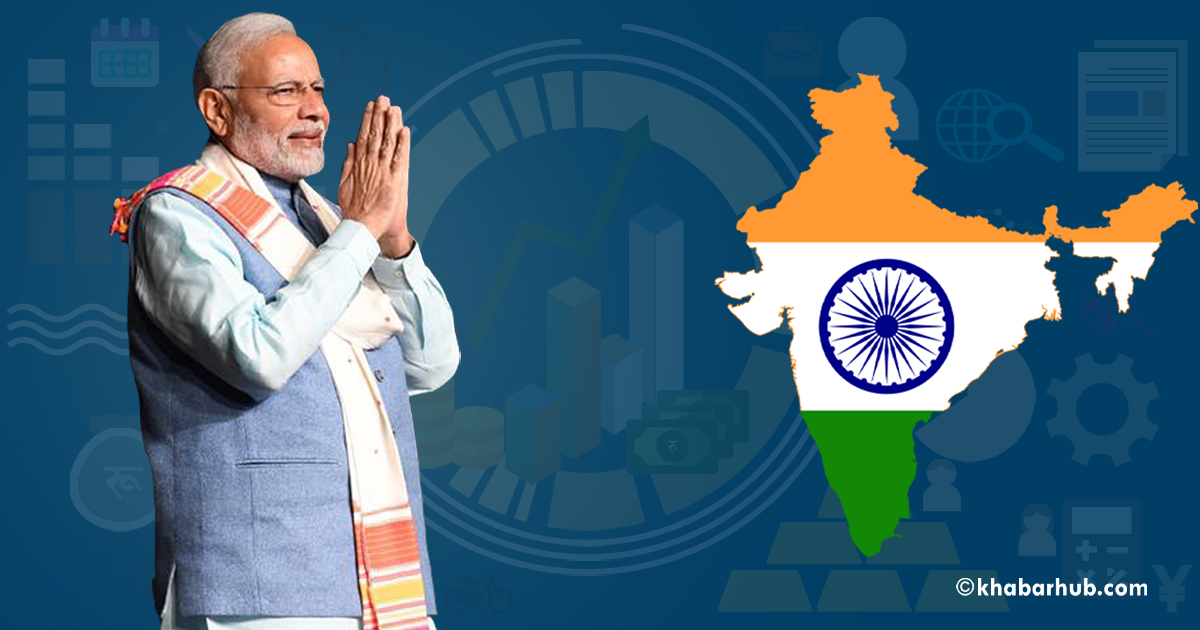Prime Minister of India, Narendra Modi has introduced five pillars of self-reliant India: Economy, Infrastructure, System, Vibrant Demography and Demand.
Background
Prime Minister Modi, in the second week of May, announced a 20 lakh crore economic package intending to make India self-reliant in the post corona world – a mission dubbed as ‘Atmanirbhar Bharat Abhiyan’.
As he unveiled the details of the economic package, which is equivalent to 10% of India’s GDP in 2019-20, Prime Minister Modi emphasized on achieving the economic self-reliance by promoting ‘local products’.
The package taken together by earlier decisions declared by the government of India during the COVID-19 crisis and decisions adopted by the country’s central bank, the Reserve Bank of India (RBI), comprises packages to cater to various sections including Cottage Industry, Micro, Small, Medium Enterprises (MSMEs), laborers, middle class, and industries, among others.
Along with these announcements, PM Modi urged people to become vocal for their local products and make them global.
The Prime Minister maintained that the definition of the term ‘self-reliance’ has seen drastic change in the globalized world. He also clarified that when a country boasts about self-reliance, it is surely indisputably different from being self-centered.
His vision is to turn the coronavirus pandemic into an opportunity that can make his country self-reliant.
In order to make India self-reliant, PM Modi introduced five pillars of self-reliant India; Economy, Infrastructure, System, Vibrant Demography and Demand.
The self-reliant India movement has visions to reform the country through the five pillars and at the same time address the financial hardships of the marginalized communities by providing relief packages.
Along with these announcements, PM Modi urged people to become vocal for their local products and make them global.
The recession caused by COVID-19 pandemic is affecting all countries in the world. While it is important to provide relief packages and health care, stimulating the economy is equally important. Turning a crisis into an opportunity like the self-reliant India movement can stimulate the economy and increase economic activity sooner.
Pradhan Mantri Garib Kalyan Package
Under the Pradhan Mantri Garib Kalyan Package, Rs. 1.70 lakh crore package is being provided to the poor population to help them fight the battle against COVID-19.
Pradhan Mantri Garib Kalyan Yojana covers all the sectors required to assure that the poor population survives safely. As per the package, insurance cover worth Rs. 50 lakh per health worker.
Around 80 crores of the poor population will be benefited from 5 kg of wheat or rice per person along with 1 kg pulses for each household for free every month for the next 3 months. The package includes gas cylinders, free of cost, provided to 8 crore poor families for the next 3 months. By these measures, the government has made sure no one dies of starvation.
Further, the Pradhan Mantri Garib Kalyan Package facilitates 20 crore women Jan Dhan account holders to get Rs 500 per month for the next 3 months. The Mahatma Gandhi National Rural Employment Guarantee Act (MNREGA) wage will be increased to Rs 202 a day from Rs 182 to benefit 13.62 crore families. As an act of ex-gratia, Rs 1,000 will be provided to 3 crore poor senior citizens, poor widows, and poor Divyang.
Similarly, Rs 2,000 will be paid to farmers under the existing PM-KISAN to benefit 8.7 crore farmers. The Building and Construction Workers Welfare Fund is now allowed to be used to provide relief to daily wage workers which is believed to provide relief to the workers during this critical time.
Also, 24% of monthly wages is to be credited into their PF accounts for the next three months for wage-earners below Rs 15,000 p.m. in businesses having less than 100 workers.
The workers registered under the Employee Provident Fund (EPF) are getting an attractive benefit. Five crore workers registered under EPF will now be benefited by the non-refundable advance of 75% of the amount or three months of the wages, whichever is lower, from their accounts.
Alongside this, the limit of collateral-free lending will also be increased from Rs 10 to Rs 20 lakhs for Women Self Help Groups supporting 6.85 crore households. The supplementing and augmenting facilities of medical testing, screening, etc will be facilitated by the District Mineral Fund (DMF).
Additionally, on the request of the Government of India, RBI has agreed to raise the Ways and Means advance limits of States by 60% and enhanced the overdraft duration limits.
As a part of social responsibility towards taxpayers, the government has issued all the pending income-tax refunds up to ₹5 lakh, immediately benefiting around 14 lakh taxpayers.
The “Special Refund and Drawback Disposal Drive” has been implemented for all pending refund and drawback claims. Both the above measures amount to ₹18,000 crores of refund. Sanctioned Rs 15,000 crores is set for Emergency Health Response Package.
Relaxation in Statutory and Compliance matters
The government has decided to extend the last date for Income Tax Returns to June 30, 2020, and filing GST returns to the end of June 2020. Similarly,
24*7 custom clearance will be extended till 30th June 2020. People can relax for 3 months as debit cardholders can now withdraw cash free from any ATMs, etc. Motor Vehicle and Health Insurance Policies can now be paid before 15 May 2020.
The Mandatory Board meetings have been officially extended by 60 days till 30 September. Extraordinary General Meetings will, however, be allowed through Video Conference with an e-voting/simplified voting facility.
Reserve Bank of India’s Measures
Government expenditure or fiscal policy is always controlled by the government, while the central bank is responsible for stimulating the economy using monetary policy such as controlling money supply or influencing the interest rate. Both fiscal policy and complement each other while stimulating an economy.
In the self-reliant India movement, the role of the RBI is crucial. To complement the measures implemented by the government of India, RBI has also taken certain measures. In order to increase the money supply in the market and enhance liquidity, the cash-reserve-ratio has been reduced.
Similarly, targeted long term repo operations (TLTRO) of Rs. 1,00,050 crore has been allocated for fresh deployment in investment-grade corporate bonds, commercial paper, and non-convertible debentures. The bank’s limit for borrowing overnight has also been increased under the marginal standing facility (MSF).
This allows the banking system to avail of an additional Rs. 1,37,000 crore of liquidity at the reduced (MSF) rate.
The central bank has also announced special refinance facilities for the National Bank for Agriculture and Rural Development (NABARD), Small
Industries Development Bank of India (SIDBI) and National Housing Bank (NHB). The amount of refinance facilities is Rs. 50,000 crore at the policy repo rate. In order to alleviate intensified liquidity pressures, the RBI is also initiating an opening of Special Liquidity Facility (SLF) of Rs. 50,000 crore for mutual funds.
A moratorium of three months on payment of installments and payment of interest on working capital facilities in respect of all term loans and easing of working capital financing by reducing margins have also been initiated by the reserve bank.
Similarly, loans by Non-Bank Financial Institutions (NBFC) to commercial real estate an additional time of one year of the extension has been given for the commencement of commercial operations.
Even though the central bank is an independent body, taking measures that complement the actions of the government can help stimulate the economy effectively. The RBI has implemented certain measures that will assist the government of India to successfully achieve self-reliance.
Cottage Industry, MSMEs, Labourers, Middle Class and Industries
As businesses — Micro, Small, Medium Enterprises (MSMEs) — have been adversely hit due to the coronavirus, they need more funding to meet their operational liabilities built up, to buy raw material, and to restart a business.
For easing this government has brought Rs 3 lakh crores Collateral-free Automatic Loans for Businesses, including MSMEs. The decision has been made to create an emergency credit line to Businesses/MSMEs from Banks and NBFCs up to 20% of entire outstanding credit as on 29.2.2020.
The borrowers with up to Rs. 25 crore outstanding and Rs. 100 crore turnover eligible for this. The loans will have a 4 year tenure with a moratorium of 12 months on Principal repayment with capped interest.
For Banks, 100% credit guarantee cover to be assured to Banks and NBFCs on principal and interest. This plan can be availed till the 31st of Oct 2020, and there will be no guarantee fee, or no collateral. The government in favor of business has decided to resume 45 lakh units business activity and safeguard jobs.
Knowing the need for equity support for stressed MSMEs, the government has decided to facilitate the provision of Rs. 20,000 crore as subordinated debt through which two lakh MSMEs are likely to be benefited. To get this benefit, functioning MSMEs which are NPA or are stressed will be eligible.
Additionally, GoI will provide a support of Rs. 4,000 crore to CGTMSE (Credit Guarantee Funds Trust for Micri and Small Enterprises) whereas, CGTMSE will provide partial Credit Guarantee support to Banks.
Likewise, the MSME promoters will be given a debt by the banks, which will then be infused by the promoters as equity in the unit. Further, for the MSMEs, facing a severe shortage of equity, Rs 50,000 crore.
Equity infusion will be done through the Fund of Funds. Equity funding will be provided for MSMEs with growth potential and viability. The FoF will also be operated through what has been termed as a ‘Mother Fund’ and few ‘daughter funds’ will help leverage Rs 50,000 crore of funds at daughter funds level.
This will help to expand MSME size as well as capacity in one hand and will encourage MSMEs to get listed on the main board of Stock Exchanges in the other hand.
New Definition of MSMEs
Since the low threshold in the definition of the MSMEs has created a fear and confusion among MSMEs of graduating out of the benefits and hence killing the urge to grow, there has been a high demand for revisions.
Finally, according to the announcement, the definition of MSMEs will be revised. As per the revision, the investment limit will be revised upwards with additional criteria of turnover being introduced. Distinction between the service sector and the manufacturing to be eliminated and amendments to the law will be brought about.
Additional Facilities to MSMEs
Indian MSMEs usually face unfair competition from large foreign companies, therefore, the government of India has introduced a strategy to not allow global tenders of up to Rs. 200 crores.
This will prevent global tenders from putting forth their application for government procurement tenders of up to Rs, 200 crores. Allowing MSMEs this facility will be a step towards achieving self-reliant India.
As MSMEs usually have a hard time surviving the competition put forth by large foreign enterprises, this step ensures that MSMEs will increase their business transactions.
Employment Provident Fund
As enterprises and employees continue to face financial stress due to the COVID-19 crisis, under the Pradhan Mantri Garib Kalyan Package (PMGKP), payment of 12% of employer and 12% employee contribution as made into Employment Provident Fund (EFP) accounts of eligible establishments.
This was organized for the past three months, March, April and May 2020 and will now be extended by another three months, June, July and August 20202.
This contribution will provide liquidity relief of Rs. 2500 crore to 3.67 lakh establishments and for 72.22 lakh employees according to the government of India.
Special Liquidity and Partial Guarantee Scheme for NBFCs/HFCs/MFIs
NBFCs/HFCs/MFIs are finding it difficult to raise money in debt markets due to COVID-19. The government is planning to launch a Rs 30,000 crore Special Liquidity Scheme under which investment will be made in both primary and secondary market transactions in investment-grade debt papers of NBFCs/HFCs/MFIs.
This will supplement both the RBI’s and the government’s measures to augment liquidity. The securities for this will be fully guaranteed by the government of India. This is likely to provide liquidity support for HFC/NBFCs/MFIs and the mutual funds as well as create confidence in the market.
As economic activity is down, NBFCs, HFCs and MFIs with low credit ratings require liquidity to do fresh lending to MSMEs and individuals.
The existing PCGS scheme, therefore, will be extended to cover the borrowings, including the primary issuance of CPs/Bonds (liability side of balance sheets) of such entities. The first 20% of loss will be borne by the guarantor, which is the government of India. This scheme will result in the liquidity of Rs 45,000 crores
Liquidity injection for DISCOMs
As the Revenues of Power Distribution Companies (DISCOMs) have plummeted due to COVID-19, the government has decided to inject Rs. 90,000 crore for DISCOMs. It should be noted that the problem of unprecedented cash flow has been accentuated by demand reduction.
Furthermore, the DISCOM payables to power generation and transmission companies has currently been Rs 94,000 crore.
In order to manage the situation, PFC/REC is to infuse liquidity of Rs 90,000 crore to DISCOMs against receivables. With this, the loans will now be granted against the State guarantees for some exclusive purpose of discharging liabilities of Gencos and Discoms.
Alongside, the digital payments facility by Discoms for consumers, liquidation of outstanding dues of State Governments, Plan to reduce financial and operational losses will be conducted. Finally, central Public Sector Generation Companies shall give rebates to Discoms which shall be passed on to the final consumers (industries).
Relief to contractors
Addressing the problems faced by the contractors, extension of up to 6 months (without costs to the contractor) is to be provided by all Central Agencies such as Railways, Ministry of Road Transport & Highways, Central Public Works Department (PWD), etc. This also covers construction/ works and goods and services contracts.
Similarly, obligations like completion of work, intermediate milestones, etc. and extension of the Concession period in PPP contracts is included in the relief package.
The government agencies will partially release bank guarantees to the contracts are partially completed.
Real Estate Projects under RERA
The real estate projects have been facing an adverse impact due to COVID. These projects stand the risk of defaulting on RERA timelines demanding the need to extend the timeline. To stabilize the problem, Ministry of Housing and Urban Affairs will advise States/UTs and their Regulatory Authorities to the following effect:
- Treat COVID-19 as an event of ‘Force Majeure’ under RERA.
- Extend the registration and completion date suo-moto by 6 months for all registered projects expiring on or after 25th March 2020 without individual applications.
- Regulatory Authorities may extend this for another period of up to 3 months if needed.
- Issue fresh ‘Project Registration Certificates’ automatically with revised timelines.
- Extend timelines for various statutory compliances under RERA concurrently.
The above-mentioned measures will de-stress real estate developers and ensure completion of projects so that homebuyers can get delivery of their booked houses with new timelines.
Tax Measures
In an effort to provide funds at the disposal of the taxpayers, the rates of Tax Deduction at Source (TDS) for the non-salaried payments have been made to residents and rates of the Tax Collection at Source (TCS) for the specified receipts will be decreased by 25% of the existing rates.
This announcement is a huge relief to every taxpayer. Payments like a contract, interest, rent, professional fees, commission, dividend, brokerage, among others will be eligible for this reduced rate of TDS. This reduction is to apply for the remaining part of the FY 2020-21 to 31st March 2021. This measure is expected to release the Liquidity of Rs. 50,000 crore.
Furthermore, the pending refunds to partnerships, charitable trusts and non-corporate businesses or professions including proprietorship, LLP and Co-operatives will be issued at the instantly.
The due date of the income tax returns for the fiscal year 2019-20 will be extended from 31st July 2020 & 31st October 2020 to 30th November 2020 and Tax audit from 30th September 2020 to 31st October 2020.
Likewise, the date of assessments getting barred on the 30th of September this year will be extended to 31st December 2020.
For those getting barred on 31st March 2021 will be extended to 30th September 2021.
Similarly, the period of Vivad se Vishwas Scheme to make payments without an additional amount will be extended to 31st December 2020.
Conclusion: Lessons to be learnt from India’s Self-Reliant Movement
The government of India has put forth an innovative plan to boost economic activity during and after the COVID-19 pandemic.
Instead of waiting for the crisis to be over India has taken this opportunity to plan ahead of time to boost not only the economic activity but also boost morale and confidence.
These measures and steps taken by India can be a learning lesson to other South Asian countries in the trying times of the COVID-19 pandemic.
The bottom line:
- Every crisis is a risk for the economy but every risk presents itself with new opportunities.
- Economic activity can only increase if and when the population’s morale and confidence are boosted.
- MSMEs are crucial for the economy, therefore should be protected and given priorities.
- Adequate and appropriate attention and justice for all, from poor to rich population, is essential in times of a crisis.
- It is never too late to bring new ideas, relief packages, and schemes to uplift the economy, address people’s and enterprises’ needs in a recession.









Comment